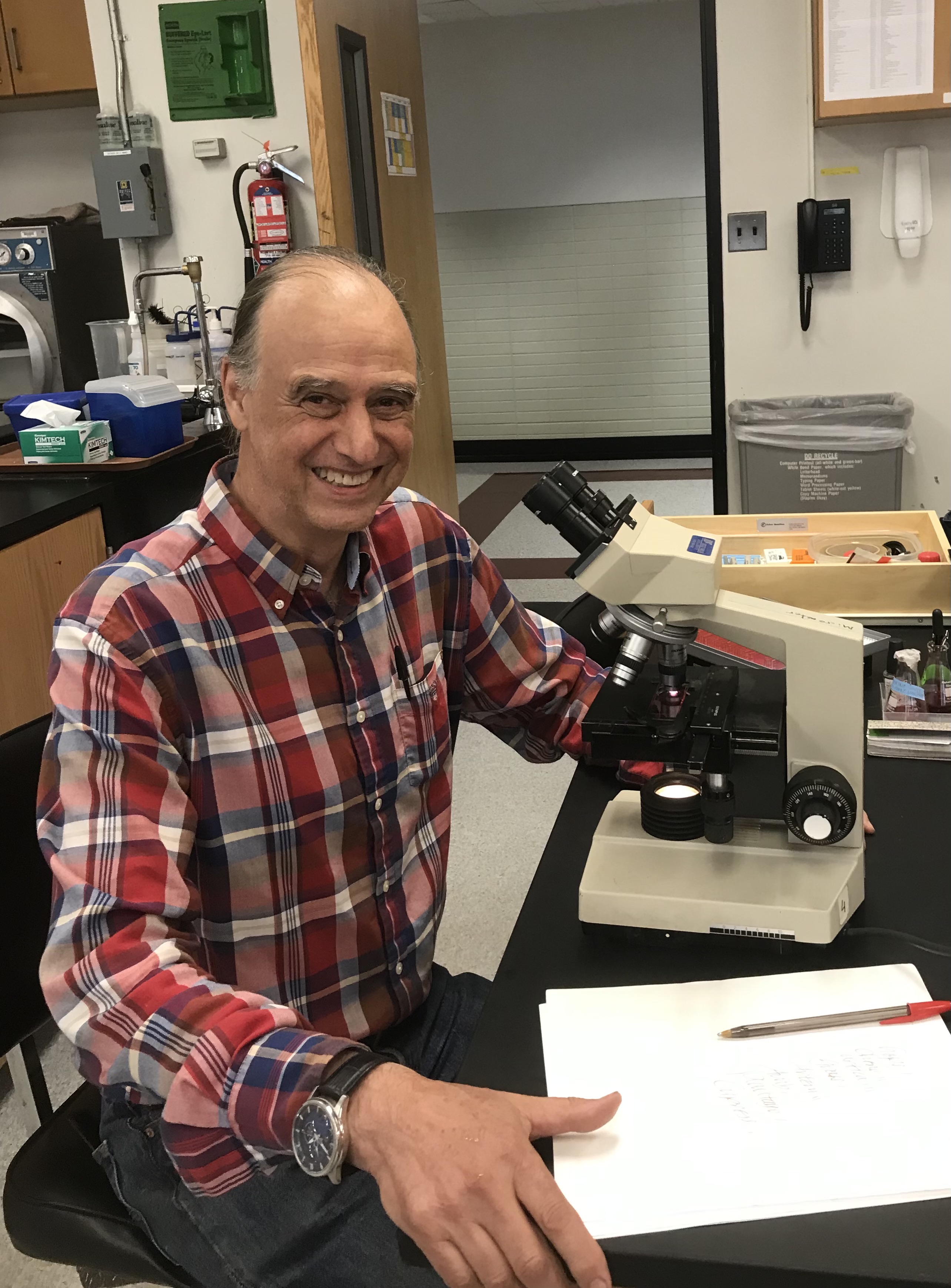Guy Robinson
-
2003. PhD (Biology), Graduate School of Arts and Sciences, Fordham University. Dissertation title: Landscape paleoecology and late Quaternary extinctions in the Hudson Valley.
1997. BS Summa cum Laude (Biology) Ignatius College, Fordham University.
-
Paleoecology is the science of learning about ecosystems and environments of the distant past. Much of the paleoecological work at Fordham examines the proposition that our Paleolithic ancestors caused the extinction of the largest land animals late in the last Ice Age. To explore this controversial question, students and I take cores out of lakes and bogs, which we then divide up as a time sequence to extract fossil pollen, spores and microscopic charcoal. Whenever our coring equipment drives into the muck and mud of a wetland, we are on our way back to the Ice Age. With radiocarbon dates we piece together narratives of environmental change, landscape fire, large animal density, and human arrival on the prehistoric landscapes of New York and elsewhere. Mastodons and other extinct animals are occasionally uncovered by local farmers. These “lucky accidents” make for great opportunities to go out and get sediment samples from actual fossil sites. All of this helps us better understand the circumstances of the last mass extinction on earth. So far, we have found that populations of charismatic animals began to crash more than 1000 years before the rapid climate shifts marking the end of the last ice age. Our pollen and microfossil records also indicate that humans had entered the New York area by 14,000 years ago, several centuries before the archaeological record begins.
The other side of our work is to measure current atmospheric pollen; what’s in the air from day to day is a matter of public health. Fordham operates the only certified aeroallergen monitoring station in New York City and another in Armonk, in the northern suburbs. I manage both these stations, and am currently collaborating with a doctoral student at Mailman School of Public Health. With help from the NYC Dept of Health, we have been able to show that allergy medication sales at New York City pharmacies will increase sharply just after a peak in our pollen counts of certain tree species. In a related project to discover the geographic variability in airborne pollen distribution across the City throughout the year, we have built and deployed 55 passive pollen traps attached to street poles throughout the five boroughs.
Fordham students working on fossil and modern pollen projects usually do this during the summer months, when they will often be joined by high school and graduate students from other institutions.
-
M.J. Power, F.E. Mayle, P.J. Bartlein, J.R. Marlon, R.S. Anderson, H. Behling ,K.J. Brown, C. Carcaillet, D. Colombaroli, D.G. Gavin, D.J. Hallett, S.P. Horn ,L.M. Kennedy, C. Lane, C. Long, P.I. Moreno, C. Paitre, G. Robinson , Z.Taylor, M. Walsh. 2013. Climatic control of the biomass-burning decline in the Americas after AD 1500. The Holocene 23: 3-13
Kate R. Weinberger, Kazuhiko Ito, Perry E. Sheffield, Guy S. Robinson, Patrick L. Kinney , and Thomas D. Matte 2011. Climate, Weather, Pollen, and Allergy Medication Sales in New York City. Report to Centers for Disease Control and Prevention
Perry E. Sheffield, Kate R. Weinberger, Kazuhiko Ito, Thomas D. Matte, Robert W. Mathes, Guy S. Robinson, and Patrick L. Kinney 2011. The Association of Tree Pollen Concentration Peaks and Allergy Medication Sales in New York City: 2003–2008. ISRN Allergy 2011, Article ID 537194, 7 pages, doi:10.5402/2011/537194
Jacquelyn L. Gill, John W. Williams, Stephen T. Jackson, Katherine B. Lininger, Guy S. Robinson 2009. Pleistocene Megafaunal Collapse, Novel Plant Communities, and Enhanced Fire Regimes in North America. Science 326, 1100-1103.
Guy S. Robinson and David A. Burney, 2008. The Hyde Park Mastodon and Palynological Clues to Megafaunal Extinction. Chapter 16 in Mastodon Paleobiology, Taphonomy, and Paleoenvironmentin the late Pleistocene of New York State: Studies on the Hyde Park, Chemung and Java Sites. edited by Warren D. Allmon and Peter L. Nester. Palaeontographica Americana, (61),pp. 291-299.
David A. Burney, and Guy S. Robinson 2008. Excavating and Interpreting Flooded Megafaunal Sites in Mastodon Paleobiology, Taphonomy, and Paleoenvironment in the late Pleistocene of New York State: Studies on the Hyde Park, Chemung and Java Sites edited by Warren D. Allmon and Peter L. Nester. Palaeontographica Americana, (61), pp. 43-48.
Guy S. Robinson, Lida P. Burney, and David A. Burney 2005. Landscape paleoecology and megafaunal extinction in southeastern New York State. Ecological Monographs 75: 295-315.
Guy S. Robinson 2005. A review of the proposed causes of the Late Pleistocene extinctions in North America. Ecological Archives M075-011-A1. (electronic archive)
D.A. Burney, G.S. Robinson, and L.P. Burney 2003. Sporormiella and the late Holocene extinctions in Madagascar. Proceedings of the National Academy of Sciences 100(19) 10800-10805.
-
2012 CSTEP (Collegiate Science and Technology Entry Program) Outstanding Service Award for mentoring students at Fordham College at Lincoln Center.
2010 W. S. Cooper Award (Ecological Society of America) for an outstanding contribution to the fields of geobotany, physiographic ecology, plant succession or the distribution of plants along environmental gradients.
-
- NSCI 1413 General Biology Laboratory I
- NSCI 1414 General Biology Laboratory II
- NSCI 4999 Palynology
